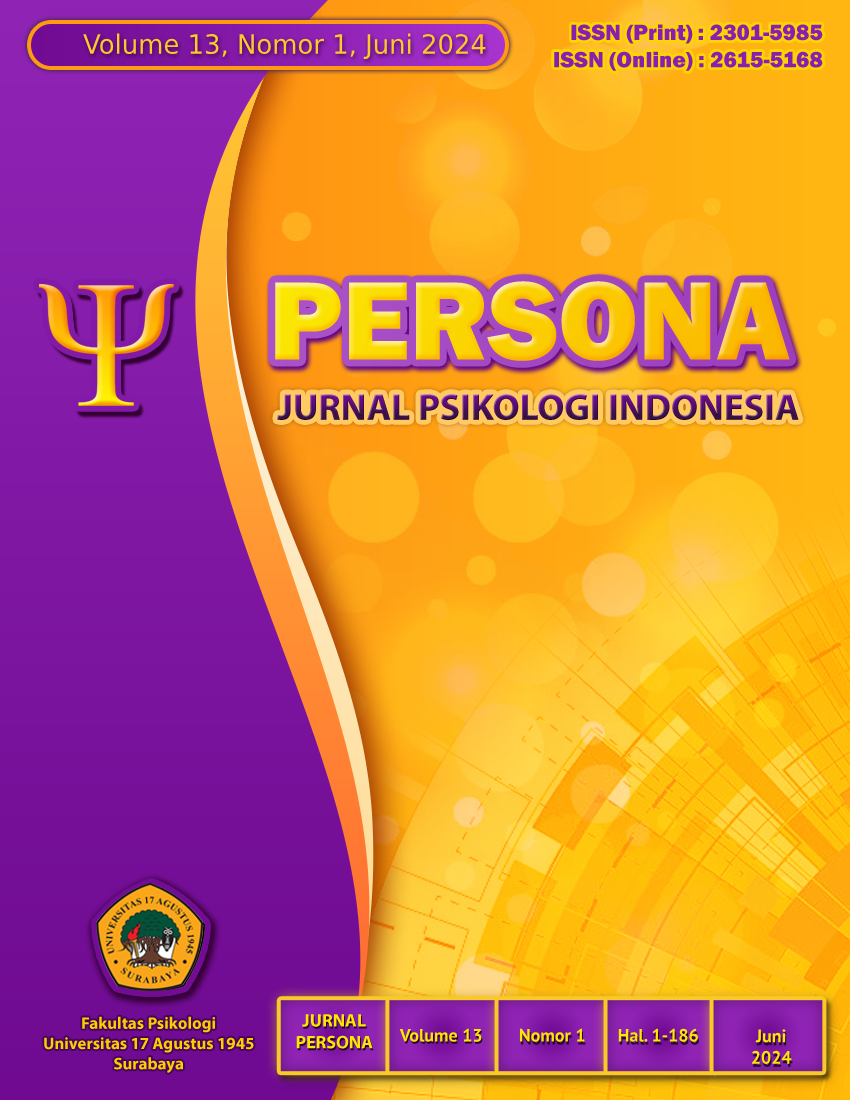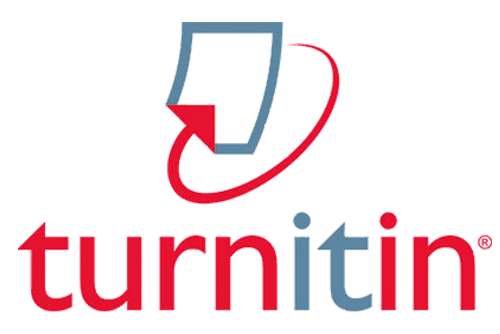Mencegah kekambuhan pada pecandu narkoba: Bagaimana peranan craving dan dukungan keluarga?
Preventing relapse in drug addicts: What is the role of craving and family support?
Abstract
Previous research data shows that drug users who have undergone rehabilitation can still experience relapse, so research that identifies factors that cause relapse is essential. This study aims to examine the relationship between craving and family support with the tendency to relapse. The research participants were 97 drug addicts undergoing rehabilitation at several rehabilitation institutions in Surabaya and Gresik. The research scale was compiled by the researcher himself, consisting of a relapse scale (α = 0.935), which refers to the theory of Gorski and Miller, a craving scale (α = 0.899), which refers to Drummond's theory, and a family support scale (α = 0.949) which refers to Friedman's theory. The research data were analyzed using multiple regression tests. The results of the partial test showed that the higher the craving in people with an addiction who had undergone rehabilitation, the higher their tendency to relapse. However, the results of the partial test also proved that solid family support made the tendency to relapse lower. The results of the study simultaneously also showed that craving and family support were predictors of the tendency to relapse in drug addicts after rehabilitation. These findings are expected to broaden understanding of clinical psychology and provide practical guidelines for former addicts to prevent relapse through efforts to reduce cravings and increase family support.
Downloads
References
Adri, A. (2023). Peringatan, ada 4,8 juta penduduk terpapar narkotika. Diambil dari https://www.kompas.id/baca/metro/2023/03/25/peringatan-ada-48-juta-penduduk-terpapar-narkotika
Ahmad, N., Khumas, A., & Fakhri, N. (2022). Seminar Nasional Psikologi self-efficacy dan kecenderungan kambuh pada pecandu narkoba yang menjalani rehabilitasi di lapas narkotika. Seminar Nasional Psikologi, 1(1). Diambil dari https://seminar.uad.ac.id/index.php/SNFP/article/view/9570/2174
Al-ziadat, M. A. (2024). Do social support and self- efficacy play a significant role in substance use relapse ?. Health Psychology Research, 8, 1–10. https://doi.org/10.52965/001c.94576
Andersson, H. W., Wenaas, M., & Nordfjærn, T. (2019). Relapse after inpatient substance use treatment: a prospective cohort study among users of illicit substances. Addictive Behaviors, 90(November 2018), 222–228. https://doi.org/10.1016/j.addbeh.2018.11.008
Aswar, A., Putra, F. R. S., & Mukhlishah, N. (2021). Peran orang tua dalam pencegahan penyalahgunaan narkoba pada remaja. Jurnal AbdiMas Bongaya, 1(1), 53–59. Diambil dari https://ojs.stiem-bongaya.ac.id/JAB/login
Aziz, M. N. F., & Budiyani, K. (2020). Hubungan antara abstinence self-efficacy dengan kencenderungan relapse pada pecandu narkoba yang menjalani rehabilitasi di yayasan Al-Islamy.
Drummond, D. C. (2001). Theories of drug craving, ancient and modern. Addiction, 96(1), 33–46. https://doi.org/10.1046/j.1360-0443.2001.961333.x
Elliott, T. R., & Rath, J. F. (2012). Rehabilitation psychology. The Oxford Handbook of Counseling Psychology. https://doi.org/10.1093/oxfordhb/9780195342314.013.0026
Farnam, A., & Mahmoodzehi, S. (2019). The relationship of negative emotions with craving and relapse rate in substance dependent subjects with relapse: mediating Role of social support. Quarterly Social Psychology Research, 9(33), 1–18. Diambil dari https://www.socialpsychology.ir/&url=http://www.socialpsychology.ir/article_91529_cc5632007980805b1f3d983616b01475.pdf?lang=en
Febriana, N. (2021). Sudah rehab tapi relapse, mengapa? (2). Diambil dari https://kumparan.com/febriana-mayasarari/sudah-rehab-tapi-relapse-mengapa-2-1wR9wUKHiAJ
Fitrianti, N., Agus, S., & Aquarisnawati, P. (2011). Pengaruh antara kematangan emosi dan self-eficacy terhadap craving pada mantan pengguna narkoba. Insan, vol 13 no(2), 106–117. Diambil dari https://eur-lex.europa.eu/legal-content/PT/TXT/PDF/?uri=CELEX:32016R0679&from=PT%0Ahttp://eur-lex.europa.eu/LexUriServ/LexUriServ.do?uri=CELEX:52012PC0011:pt:NOT
Fortuna, J. L., & Smelson, D. A. (2008). The phenomenon of drug craving. Journal of Psychoactive Drugs, 40(3), 255–261. https://doi.org/10.1080/02791072.2008.10400640
Friedman, M. M., Bowden, V. R., & Jones, E. G. (2010). Buku ajar keperawatan keluarga: Riset, teori, dan praktek. Jakarta: Egc, 5–6.
Ghozali, I. (2016). Aplikasi analisis multivariete dengan program IBM SPSS 23. Badan Penerbit UNDIP. (8 ed.). Semarang: Univ. Diponegoro Press. Diambil dari https://digilib.itbwigalumajang.ac.id/index.php?p=show_detail&id=2775
Gorski, T. T., & Miller, M. (1986). Staying sober : a guide for relapse prevention. Herald House/Independence Press.
Harbia, H., Multazam, A., & Asrina, A. (2018). The impact of the abuse of narcotic drugs, psychotropic drugs and other addictive substances (drugs) against premarital sex behaviors. Window of Health : Jurnal Kesehatan, (March), 204–216. https://doi.org/10.33368/woh.v1i3.68
Jannah, F., & Satiningsih. (2023). Self-control pada pasien pecandu narkoba. Character : jurnal penelitian psikologi, 10(03), 664–675. Diambil dari https://ejournal.unesa.ac.id/index.php/character/article/download/54534/43375/
Kabisa, E., Biracyaza, E., Habagusenga, J. d’Amour, & Umubyeyi, A. (2021). Determinants and prevalence of relapse among patients with substance use disorders: case of Icyizere Psychotherapeutic Centre. Substance Abuse: Treatment, Prevention, and Policy, 16(1), 1–12. https://doi.org/10.1186/s13011-021-00347-0
Kharb, R., Shekhawat, L., Beniwal, R., Bhatia, T., & Deshpande, S. (2018). Relationship between craving and early relapse in alcohol dependence: A short-term follow-up study. Indian Journal of Psychological Medicine, 40(4), 315–321. https://doi.org/10.4103/IJPSYM.IJPSYM_558_17
Kusuma, F. (2023). Relapse setelah rehabilitasi, kok bisa? Badan Narkotika Nasional Provinsi Daerah Istimewa Yogyakarta. Diambil dari https://yogyakarta.bnn.go.id/relapse-setelah-rehabilitasi-kok-bisa/
Kusuma, R. H. (2020). Penerapan konseling adiksi narkoba di balai rehabilitasi badan narkotika nasional (bnn) tanah merah samarinda. Islamic Counseling: Jurnal Bimbingan Konseling Islam, 4(1), 1. https://doi.org/10.29240/jbk.v4i1.1375
Muhammad, N. (2023). 10 Provinsi dengan jumlah kasus narkoba terbanyak 2022 di Indonesia, Jawa Timur teratas. Diambil dari https://databoks.katadata.co.id/datapublish/2023/07/07/10-provinsi-dengan-jumlah-kasus-narkoba-terbanyak-2022-di-indonesia-jawa-timur-teratas#:~:text=Berdasarkan laporan yang dipublikasi Badan,pidana narkoba terbanyak pada 2022.
National Institute on Drug Abuse. (2023). Treatment and recovery. Diambil dari https://nida.nih.gov/publications/drugs-brains-behavior-science-addiction/treatment-recovery
Pertama, I. A., Suwarni, L., & Abrori, A. (2019). Gambaran faktor internal dan eksternal yang mempengaruhi kejadian relapse pecandu narkoba di kota Pontianak. Jurnal Kesmas (Kesehatan Masyarakat) Khatulistiwa, 6(3), 79. https://doi.org/10.29406/jkmk.v6i3.1771
Pooroe, I. G., Yuniwati, E. S., & Wungubelen, B. L. (2023). Dukungan sosial keluarga terhadap anggota keluarga yang menderita HIV/AIDS Di kota Malang. Psikovidya, 26(2), 61–70. https://doi.org/10.37303/psikovidya.v26i2.210
Pratama, Yudi, Syahrial, & Saifuddin, I. (2015). Hubungan keluarga pasien terhadap kekambuhan skizofrenia di badan layanan umum daerah (blud) Rumah Sakit Jiwa Aceh. Jurnal Kedokteran Syiah Kuala, 15(2), 77–86. Diambil dari https://jurnal.usk.ac.id/JKS/article/download/3258/3082
Public Relations BNN. (2019). Daftar tempat rehabilitasi narkoba di Indonesia. Diambil dari https://bnn.go.id/daftar-tempat-rehabilitasi-narkoba-di-indonesia/
Public Relations MenPANR. (2022). Cegah peredaran gelap narkotika, sosialisasi P4GN digencarkan di kementerian PANRB. Diambil dari https://www.menpan.go.id/site/berita-terkini/cegah-peredaran-gelap-narkotika-sosialisasi-p4gn-digencarkan-di-kementerian-panrb
Puslitdatin-BNN. (2022). Indonesia drugs report tahun 2022. Jakarta Timur: Badan Narkotika Nasional.
Puspita, R. (2018). BNN: 70 persen pecandu narkoba relapse setelah rehabilitasi. Diambil dari https://news.republika.co.id/berita/p5w2eo428/bnn-70-persen-pecandu-narkoba-relapse-setelah-rehabilitasi
Ramadhanti, M., Supiadi, E., & Sundayani, Y. (2019). Upaya pencegahan relapse korban penyalahgunaan napza di institusi penerima wajib lapor (ipwl) bumi kaheman Desa Bandasari Kecamatan Cangkuang Kabupaten Bandung. REHSOS: Jurnal Ilmiah Rehabilitasi Sosial, 1(2), 141–163. Diambil dari https://download.garuda.kemdikbud.go.id/article.php?article=2456461&val=23421&title=UPAYA PENCEGAHAN RELAPSE KORBAN PENYALAHGUNAAN NAPZA DI INSTITUSI PENERIMA WAJIB LAPOR IPWL BUMI KAHEMAN DESA BANDASARI KECAMATAN CANGKUANG KABUPATEN BANDUNG
Saadah, N. (2020). Self efficacy mantan pecandu narkoba dalam menghadapi craving. Universitas Maulana Malik Ibrahim. Diambil dari http://etheses.uin-malang.ac.id/26337/3/16410219.pdf
Sapkota, S., Khadka, A., & Akela, G. (2016). Contributing factors to relapse of drug addiction among clients attending rehabilitation Centres Of Dharan, Nepal S. Journal of Chitwan Medical College, 6(17), 20–25. Diambil dari https://www.jcmc.com.np/jcmc/index.php/jcmc/article/view/862
Sari, N. L. K. R., Hamidah, H., & Marheni, A. (2020). Terapi kognitif perilaku untuk menurunkan potensi kekambuhan pada narapidana mantan pecandu narkoba. Intuisi : Jurnal Psikologi Ilmiah, 12(1), 113–122. https://doi.org/10.15294/intuisi.v12i1.22276
Simangunsong, F. (2014). Faktor-faktor penyebab penyalahgunaan narkotika. In PROSEDING SEMINAR UNSA (hal. 1–5). Diambil dari https://ejournal.unsa.ac.id/index.php/prosedingunsa/article/view/76
Sumakul, E. V. P., & Yuwono, E. S. (2023). Hubungan antara adversity quotient terhadap craving pada mantan pecandu narkoba di Kota Manado. INNOVATIVE: Journal Of Social Science Research, 3(3), 4373–4384. Diambil dari https://j-innovative.org/index.php/Innovative/article/view/2621
Syuhada, I. (2015). Faktor internal dan intervensi pada kasus penyandang relaps narkoba. Psychology Forum UMM, 501–505. Diambil dari https://mpsi.umm.ac.id/files/file/501-505 Irwan.pdf
Winata, T. P., Natalia, S., Rahmacahyani, R., & Humaedi, S. (2021). Family support terhadap mantan penyalahguna napza dalam mencegah terjadinya relapse (kekambuhan). Focus: Jurnal Pekerjaan Sosial, Departemen Kesejahteraan Sosial FISIP Universitas Padjadjaran, 4(2). Diambil dari https://jurnal.unpad.ac.id/focus/article/view/31906
Wuryantari, N., & Ghozali, G. (2020). Literature review hubungan kepercayaan diri dengan sikap pencegahan relapse pada pengguna narkoba yang menjalani rehabilitasi narkoba. Borneo Student Research (BSR), 2(1), 465–473. Diambil dari https://journals.umkt.ac.id/index.php/bsr/article/view/1736
Yunitasari, I. (2018). Hubungan dukungan keluarga dan self-efficacy dengan upaya pencegahan relapse pada penyalahguna napza pasca rehabilitasi. Psikoborneo: Jurnal Ilmiah Psikologi, 6(2), 280–289. https://doi.org/10.30872/psikoborneo.v6i2.4571
Zaidi, U. (2020). Role of social support in relapse prevention for drug addicts. International Journal of Innovation, Creativity and Change, 13(1), 915–924. Diambil dari https://www.researchgate.net/profile/Uzma-Zaidi-2/publication/343193788_Role_of_Social_Support_in_Relapse_Prevention_for_Drug_Addicts/links/5f1b40cc45851515ef477eaa/Role-of-Social-Support-in-Relapse-Prevention-for-Drug-Addicts.pdf
Copyright (c) 2024 Niken Titi Pratitis; Muhammad Rizky Fananni

This work is licensed under a Creative Commons Attribution-ShareAlike 4.0 International License.
The author who will publish the manuscript at Persona: Jurnal Psikologi Indonesia, agree to the following terms:
1. Authors retain copyright and grant the journal right of first publication with the work simultaneously licensed under a Creative Commons Attribution ShareAlike License that allows others to share the work with an acknowledgment of the work's authorship and initial publication in this journal.
2. Authors are able to enter into separate, additional contractual arrangements for the non-exclusive distribution of the journal's published version of the work (e.g., post it to an institutional repository or publish it in a book), with an acknowledgment of its initial publication in this journal.
3. Authors are permitted and encouraged to post their work online (e.g., in institutional repositories, pre-prints sites or on their website) prior to and during the submission process, as it can lead to productive exchanges, as well as earlier and greater dissemination of published work








